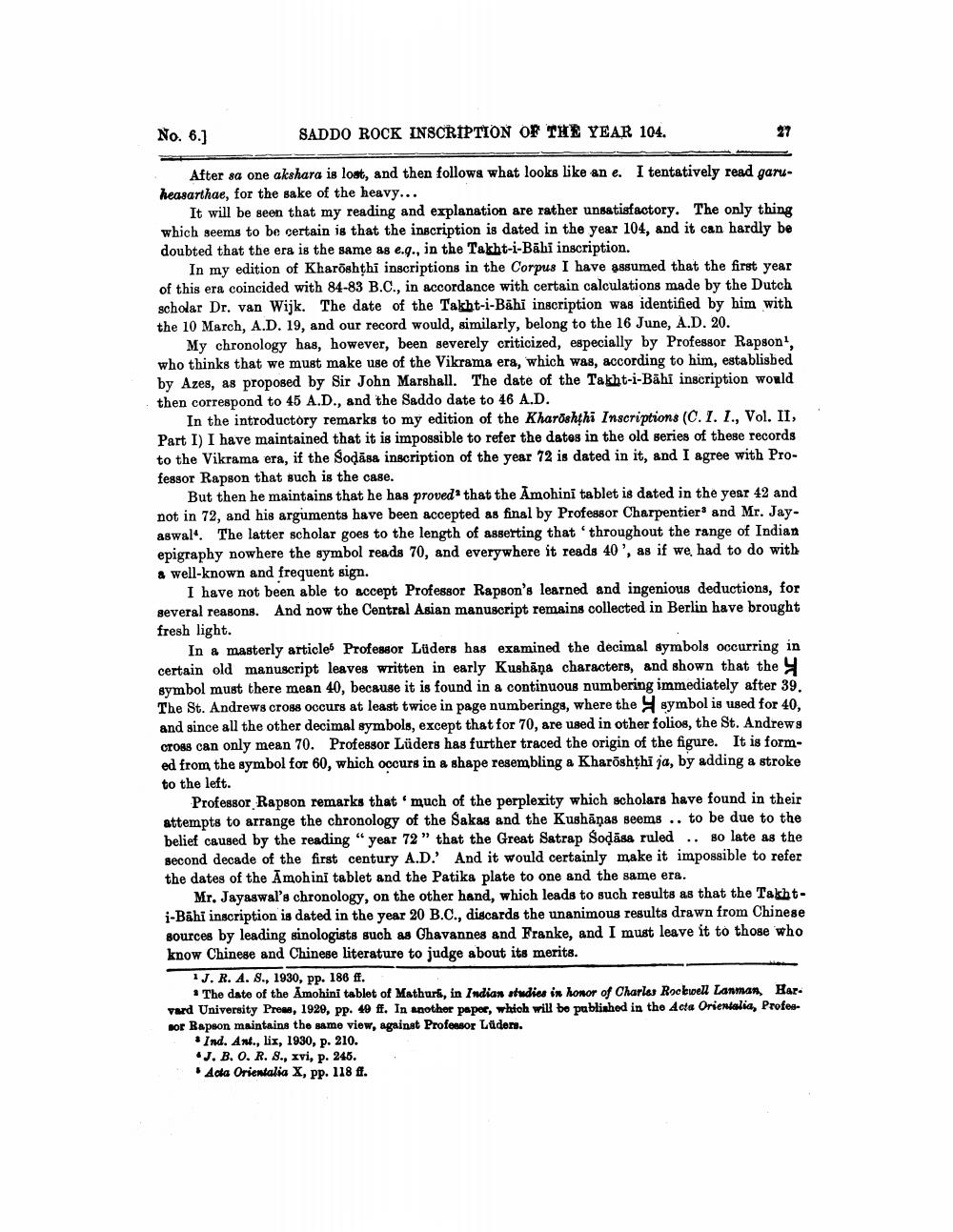________________
No. 6.]
SADDO ROCK INSCRIPTION OF THE YEAR 104.
After sa one akshara is lost, and then follows what looks like an e. I tentatively read garuheasarthae, for the sake of the heavy...
It will be seen that my reading and explanation are rather unsatisfactory. The only thing which seems to be certain is that the inscription is dated in the year 104, and it can hardly be doubted that the era is the same as e.q., in the Takht-i-Bahi inscription.
In my edition of Kharōshthi inscriptions in the Corpus I have assumed that the first year of this era coincided with 84-83 B.C., in accordance with certain calculations made by the Dutch scholar Dr. van Wijk. The date of the Takht-i-Bahi inscription was identified by him with the 10 March, A.D. 19, and our record would, similarly, belong to the 16 June, A.D. 20.
27
My chronology has, however, been severely criticized, especially by Professor Rapson1, who thinks that we must make use of the Vikrama era, which was, according to him, established by Azes, as proposed by Sir John Marshall. The date of the Takht-i-Bahi inscription would then correspond to 45 A.D., and the Saddo date to 46 A.D.
In the introductory remarks to my edition of the Kharoshthi Inscriptions (C. I. I., Vol. II, Part I) I have maintained that it is impossible to refer the dates in the old series of these records to the Vikrama era, if the Soḍasa inscription of the year 72 is dated in it, and I agree with Professor Rapson that such is the case.
But then he maintains that he has proved that the Amohini tablet is dated in the year 42 and not in 72, and his arguments have been accepted as final by Professor Charpentiers and Mr. Jayaswal. The latter scholar goes to the length of asserting that throughout the range of Indian epigraphy nowhere the symbol reads 70, and everywhere it reads 40', as if we had to do with a well-known and frequent sign.
I have not been able to accept Professor Rapson's learned and ingenious deductions, for several reasons. And now the Central Asian manuscript remains collected in Berlin have brought fresh light.
In a masterly articles Professor Lüders has examined the decimal symbols occurring in certain old manuscript leaves written in early Kushana characters, and shown that the symbol must there mean 40, because it is found in a continuous numbering immediately after 39. The St. Andrews cross occurs at least twice in page numberings, where the symbol is used for 40, and since all the other decimal symbols, except that for 70, are used in other folios, the St. Andrews cross can only mean 70. Professor Lüders has further traced the origin of the figure. It is formed from the symbol for 60, which occurs in a shape resembling a Kharōshthi ja, by adding a stroke to the left.
Professor Rapson remarks that much of the perplexity which scholars have found in their attempts to arrange the chronology of the Sakas and the Kushanas seems.. to be due to the belief caused by the reading "year 72" that the Great Satrap Soḍāsa ruled.. so late as the second decade of the first century A.D.' And it would certainly make it impossible to refer the dates of the Amohini tablet and the Patika plate to one and the same era.
Mr. Jayaswal's chronology, on the other hand, which leads to such results as that the Takhti-Bahi inscription is dated in the year 20 B.C., discards the unanimous results drawn from Chinese sources by leading sinologists such as Chavannes and Franke, and I must leave it to those who know Chinese and Chinese literature to judge about its merits.
1 J. R. A. S., 1930, pp. 186 ff.
The date of the Amohini tablet of Mathura, in Indian studies in honor of Charles Rockwell Lanman, Harvard University Press, 1929, pp. 49 ff. In another paper, which will be published in the Acta Orientalia, Professor Rapson maintains the same view, against Professor Lüders.
Ind. Ant., lix, 1930, p. 210.
J. B. O. R. S., xvi, p. 245.
Acta Orientalia X, pp. 118 ff.




